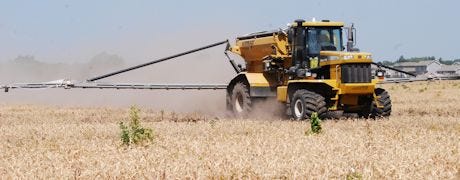
USDA's Risk Management Agency recently ruled that farmers can plant soybeans as a cover crop on "prevented planting" acres. That's a good use for treated seed that didn't get planted due to the extremely wet conditions and planting delays this year. Instead of planting those delayed acres to beans in late June and early July, some farmers elected to take the "prevented planting" option that their crop insurance policy offers -- prevented planting pays 60% of the revenue guarantee.

BROADCASTING BEANS: On July 11 this fertilizer applicator was being used by Heartland Co-op to broadcast soybean seed on some "prevented planting" acres in central Iowa. USDA's Risk Management Agency recently ruled farmers can plant soybeans as a cover crop, which is a good use for treated seed that's leftover from the regular planting season. But you can't harvest it for grain, and if you want to graze it or bale it for forage, you can't do anything with any cover crop prior to November 1.
It is recommended that farmers plant a cover crop on these acres rather than letting them sit "empty" this year, says Iowa State University Extension agronomist Steve Barnhart. There are a number of erosion control, weed control and other agronomic benefits that a cover crop can offer. Many of these farmers are using rye or a legume or a mixture of other "regular" forage seedings as cover crops. However, some farmers who have treated soybean seed that's leftover from the regular planting season (seed that wasn't used this spring) have been pushing USDA/RMA to allow soybeans to be used as a cover crop.
Finally, in early July USDA's Risk Management Agency ruled that farmers can plant soybeans as a cover crop. But you have to realize you can't harvest that crop for grain. Also, if you want to graze or bale any cover crop for forage, you can't do that before November 1. Some groups such as the Iowa Cattlemen's Association and others are asking USDA to move that date forward to allow earlier grazing or haying which would put that forage to better use as opposed to waiting until November 1.
Farmers reminded to handle unplanted, leftover treated seeds properly
Iowa farmers are reminded to properly handle treated seeds that were unable to be planted this year due to the historically wet spring weather. Seeds treated with a pesticide to protect them from pests or disease cannot enter the grain supply, so it is important that treated seed be stored for planting next year or disposed of properly.
If a farmer chooses to keep the seed, the leftover treated seed must be stored separately from grain and properly labeled to indicate the type of seed treatment, according to a press release issued by the Iowa Department of Agriculture & Land Stewardship on July 10. The seed should be stored in a dry, well-ventilated location and the percentage of germination checked before use.~~~PAGE_BREAK_HERE~~~
Some farmers in late June and early July decided to quit planting beans and take the "prevented planting" on their unplanted soybean acres that is offered by crop insurance. So they talked with their seed dealer as the dealers may have been able to help arrange for the seed to be moved to another farmer so that it can still be planted yet this year. The following information comes from the Iowa Department of Agriculture.
Your best option for a small amount of leftover seed may be to plant it somewhere
If a farmer does choose to dispose of the seed, the best option for a small quantity of leftover seed may be to plant it in fallow or other non-cropped areas of the farm. Note that treated seed may be hazardous to wildlife and must be planted according to seed label and bag instructions.
Planting treated soybeans on acres that farmers were prevented from planting this year may also be an option. Some crop insurance companies are now allowing the use of treated soybean seed as a cover crop. It is critically important that a farmer have the approval of their insurance company before using treated soybeans as a cover crop. In addition, if herbicide was applied to an area that was going to be planted to corn that is now going to be planted to a different crop, the herbicide label should be checked to be sure that crop can be used with that herbicide.
Other disposal options for treated seeds include taking them to the county landfill so they can be buried properly
Other disposal options for treated seeds include incineration in a boiler, such as at a power plant or cement kiln that is permitted to burn treated seed as a fuel source.
Disposal at a state permitted solid waste disposal facility may also be possible, especially if a farmer has a large quantity of treated seed in need of disposal. Farmers should contact the Iowa DNR Solid Waste section at 515-281-6807 for more information on disposal at these facilities.
More information about disposal of treated seeds can be found on the American Seed Association's online seed treatment guide.
About the Author(s)
You May Also Like




